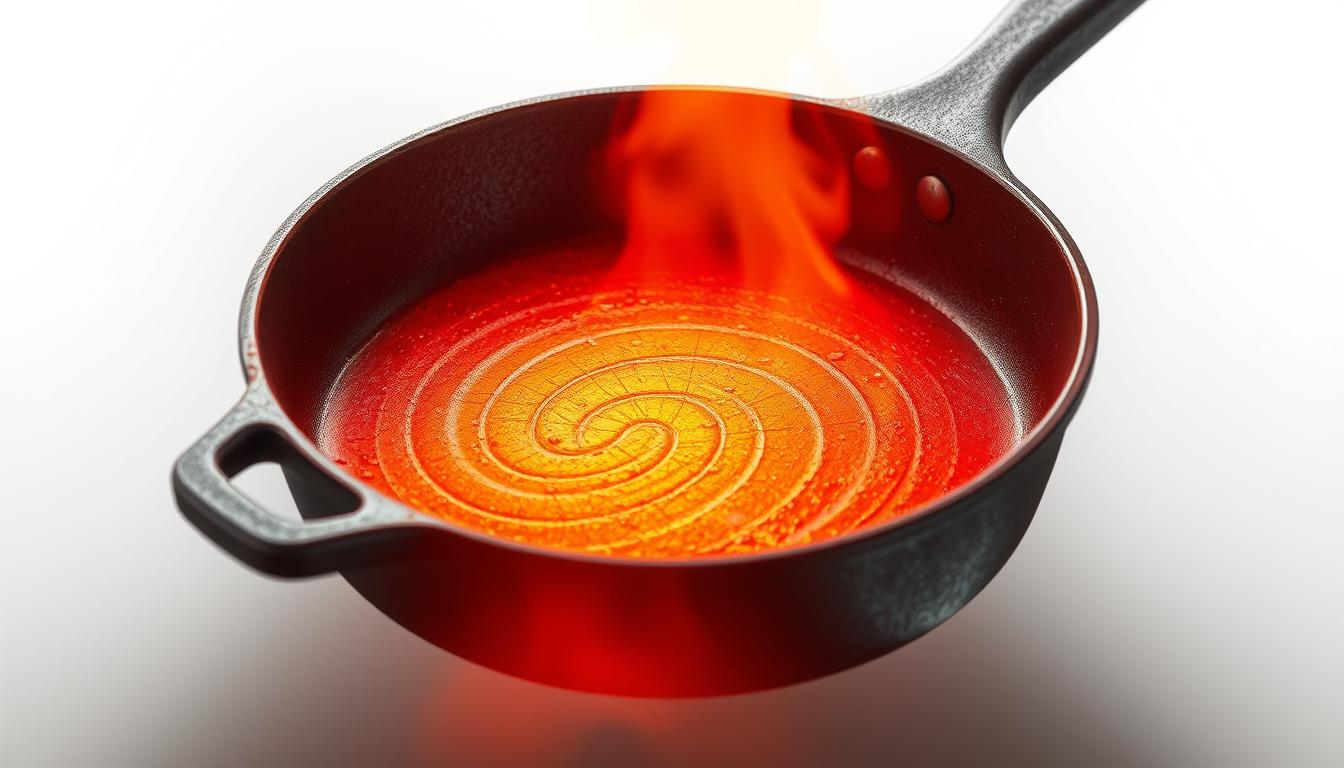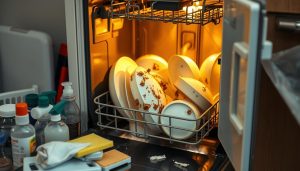Did you know a standard 12-inch skillet stores enough thermal energy to sear six steaks after removing it from the burner? This powerhouse performance comes from cookware forged through centuries of metallurgical refinement. Unlike modern alternatives, these vessels owe their heat-holding superpowers to a unique combination of density and design.
Manufacturers craft these pieces at 4mm thickness—nearly double most stainless steel pans—to balance durability with even heating. The material’s crystalline structure traps thermal energy like a battery, releasing it gradually across your cooking surface. This explains why chefs achieve perfect crusts on ribeyes and golden-brown cornbread edges using the same versatile tool.
You’ll notice the weight difference immediately. A typical 10-inch model weighs 5 pounds—heavier than three aluminum pans combined. That mass isn’t just for show. It creates a stable thermal environment that prevents sudden temperature drops when adding ingredients. From blistering sears to gentle simmers, this cookware adapts to your technique rather than forcing compromises.
Key Takeaways
- Thicker construction (4mm) enhances durability and heat distribution
- High-density material stores 25% more thermal energy than copper pans
- Slow heat release enables consistent cooking across various techniques
- Weighted base prevents hot spots during prolonged use
- Performs equally well on induction stovetops and campfires
The Science of Cast Iron: Material and Molecular Mysteries
What gives this cookware its legendary heat distribution? The secret lies in its atomic blueprint. At the microscopic level, iron atoms form a tight ferrite lattice—like soldiers standing shoulder-to-shoulder. This crystalline arrangement acts as a superhighway for thermal energy.

Metal That Remembers Heat
Traditional skillets gain their power during creation. Molten metal poured into sand molds cools slowly, allowing iron crystals to grow in specific patterns. This grain structure determines how heat flows across your cooking surface.
Compare this to thin stainless steel pans. Their rushed manufacturing leaves chaotic molecular arrangements. The result? Hot spots that burn your grilled cheese. Cast iron’s 4mm+ thickness adds multiple heat pathways, like adding extra lanes to a busy highway.
| Material | Heat Distribution | Thermal Mass |
|---|---|---|
| Cast Iron | 95% even | High |
| Aluminum | 80% even | Medium |
| Stainless Steel | 70% even | Low |
From Furnace to Kitchen
The casting process does more than shape metal—it programs thermal behavior. As liquid iron solidifies, it locks in durability that handles oven-to-grill temperature swings. This explains why Uno Casa’s cast iron skillet set maintains consistent performance decade after decade.
Your seared steak’s perfect crust isn’t luck. It’s physics—iron atoms working in unison to store and release energy precisely. Whether baking cornbread or searing scallops, that molecular memory delivers restaurant-quality results on your stovetop.
Real-World Cooking Insights and Experiment Findings
Laboratory tests reveal surprising truths about cookware performance. When simmering broth or searing meats, your choice of material impacts results more than fancy knife skills.

Kitchen Experiments and Temperature Retention
Controlled studies show watery dishes behave differently. A Staub Dutch oven maintained a 2°F edge over aluminum pans when boiling 4 quarts of water. Why? Water stores 10x more thermal energy per pound than cast iron.
In stews and soups, the liquid becomes the main heat source. But try roasting vegetables or searing chops—that’s where thick iron shines. One test showed temperature gaps widened from 2°F to 6°F over 27 minutes when cooking drier foods.
| Material | Heat Capacity (J/g°C) |
|---|---|
| Water | 4.18 |
| Cast Iron | 0.46 |
| Aluminum | 0.90 |
Debunking Common Myths
“Heavier pans always retain heat better” proves half-true. While 4mm-thick iron outperforms thin aluminum, a disc-base stainless steel pot nearly matched its thermal mass in testing. Your cooking technique determines which tool wins.
For quick sautés? Reach for lighter pans. Slow-cooked braises? That’s iron’s playground. As one chef noted: “It’s not about having the ‘best’ cookware—it’s about using the right soldier for each battle.”
Practical Techniques for Preheating and Seasoning
Mastering cast iron requires two fundamental skills most home cooks overlook. Proper preparation transforms these heavy pans into culinary workhorses, whether you’re crisping bacon or baking artisan bread. Let’s break down the methods professionals use daily.

Preheating Strategies for Even Cooking
Start your pan cold. Gradually warm it over low-medium heat for 5-7 minutes—this prevents warping and ensures uniform expansion. Thermal shock occurs when cold food hits a scorching surface, creating uneven cooking zones.
Test readiness with water droplets. A properly heated surface makes water dance like mercury before evaporating. For searing, wait until droplets vaporize instantly. This “Leidenfrost effect” signals ideal surface contact.
Seasoning for Enhanced Non-Stick Performance
Think of seasoning as armor plating. When oil polymerizes at 400°F, it bonds with the metal to create a slick surface. Avocado oil works best—its high smoke point (520°F) prevents sticky residues.
Apply oil in paper-thin layers using a lint-free cloth. Bake upside-down for 60 minutes to prevent pooling. Repeat monthly or after acidic dishes. Well-maintained pans develop a glossy black finish that outperforms Teflon.
Practical Applications: Understanding Cast Iron Heat Retention in Your Cooking
Ever wonder why professional chefs reach for the same heavy pan across various cooking methods? Your cookware’s ability to hold steady temperatures determines whether you get soggy vegetables or caramelized perfection. Let’s explore techniques that turn this material into your kitchen’s MVP.

Precision Cooking Through Thermal Control
For steakhouse-quality searing, preheat your pan until water droplets skitter like marbles. The mass beneath the surface keeps temperatures from crashing when cold meat hits the metal. You’ll get uniform crust formation without overcooking centers.
Slow-simmered dishes thrive in Dutch ovens. Their heat-storing walls maintain gentle bubbles for hours. Unlike thin pots that cycle between boil and simmer, these vessels let flavors develop evenly.
| Cooking Method | Ideal Cookware | Thermal Advantage |
|---|---|---|
| Searing | 12″ Skillet | Maintains 450°F+ surface |
| Baking | 10″ Pan | Even bottom heat |
| Simmering | 5qt Dutch Oven | ±2°F fluctuations |
| Outdoor | Camp Chef | Flame variation buffer |
When baking cornbread, position racks in the oven’s lower third. The pan’s radiant base browns crusts while preventing burnt edges. For large batches, cook proteins in thirds—the metal recovers heat faster than stainless steel.
Campfire chili tastes better when your pot compensates for shifting flames. The material’s thermal inertia smooths out temperature spikes, giving consistent results over open fires. From backyard grills to induction tops, this cookware adapts while delivering signature results.
Maintaining and Caring for Your Cast Iron Cookware
Your cookware’s legendary performance depends on proper care. Preserve its heat management and natural non-stick qualities with methods perfected through generations of kitchen wisdom.
Cleaning Without Compromising Seasoning
Use warm water and a stiff-bristle brush immediately after cooking. Avoid soaking—prolonged water exposure breaks down protective oil layers. For stubborn residue, sprinkle coarse salt and scrub with a damp cloth.
Dry thoroughly using your stovetop. Place the pan over low heat for 3-5 minutes until all moisture evaporates. This step prevents microscopic rust formation that weakens structural integrity.
Regular Maintenance for Longevity
Apply a thin oil coat while the surface is warm. Grapeseed or flaxseed oils work best—their molecular structure bonds tightly with metal when heated. Wipe excess with a paper towel to avoid sticky buildup.
Store pans in dry areas with airflow. Never stack unprotected pieces—use paper towel separators. With proper care, your cookware develops superior seasoning over time, enhancing both cooking performance and rust resistance.
| Maintenance Step | Frequency | Benefit |
|---|---|---|
| Oil Application | After Each Use | Strengthens Seasoning |
| Heat Drying | Post-Cleaning | Prevents Oxidation |
| Deep Clean | Annually | Removes Carbon Buildup |
Conclusion
Your kitchen arsenal gains unmatched versatility through material mastery. The fusion of dense metal engineering and time-tested methods transforms ordinary meals into culinary achievements. Proper preheating and strategic seasoning unlock your cookware’s full potential, creating a loyal kitchen companion that outperforms modern alternatives.
Regular maintenance doesn’t just preserve your pan—it enhances its natural thermal properties. Each oil application strengthens the surface, while controlled heating prevents energy loss. These practices ensure decades of reliable service, whether searing steaks or baking artisan bread.
Apply these principles to experience why generations cherish this kitchen essential. Its ability to maintain steady temperatures revolutionizes outdoor cooking and precision baking alike. From campfire chili to golden-crusted cornbread, you’ll achieve consistent results that lighter pans can’t match.
Your investment in cast iron pays dividends through every meal. Treat it as a living tool that improves with use, and watch it become the most versatile player in your culinary lineup. The science-backed techniques you’ve mastered guarantee professional outcomes, proving great cooking starts with exceptional tools.



